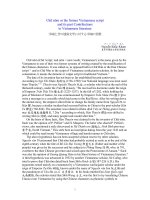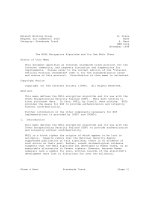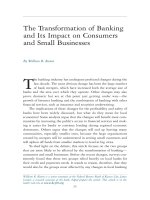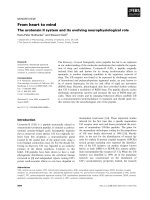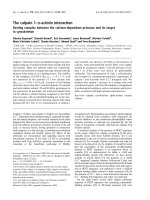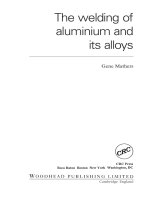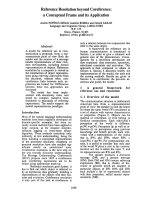- Trang chủ >>
- Khoa Học Tự Nhiên >>
- Vật lý
beyond the einstein addition law and its gyroscopic thomas precession
Bạn đang xem bản rút gọn của tài liệu. Xem và tải ngay bản đầy đủ của tài liệu tại đây (5.08 MB, 462 trang )
Beyond the Einstein Addition Law and its Gyroscopic Thomas Precession
Wissenschaften, Germany
ALWYN VAN DER MERWE,
University of Denver, U.S.A.
Fundamental Theories of Physics
An International Book Series on The Fundamental Theories of Physics:
Their Clarification, Development and Application
Editor:
Editorial Advisory Board:
JAMES T. CUSHING, University of Notre Dame, U.S.A.
GIANCARLO GHIRARDI, University of Trieste, Italy
LAWRENCE P. HORWITZ, Tel-Aviv University, Israel
BRIAN D. JOSEPHSON, University of Cambridge, U.K.
CLIVE KILMISTER, University of London, U.K.
PEKKA J. LAHTI, University of Turku, Finland
ASHER PERES, Israel Institute of Technology, Israel
EDUARD PRUGOVECKI, University of Toronto, Canada
TONY SUDBURY, University of York, U.K.
HANS-JÜRGEN TREDER, Zentralinstitut für Astrophysik der Akademie der
Volume 117
Addition Law
Beyond the Einstein
and its Gyroscopic
Thomas Precession
The Theory of Gyrogroups and
Gyrovector Spaces
by
Abraham A. Ungar
Department of Mathematics,
North Dakota State University,
Fargo, North Dakota, U.S.A.
KLUWER ACADEMIC PUBLISHERS
NEW YORK, BOSTON
,
DORDRECHT
,
LONDON
,
MOSCOW
©2002 Kluwer Academic Publishers
New York, Boston, Dordrecht, London, Moscow
All rights reserved
No part of this eBook may be reproduced or transmitted in any form or by any means, electronic,
mechanical, recording, or otherwise, without written consent from the Publisher
Created in the United States of America
Visit Kluwer Online at:
and Kluwer's eBookstore at:
Print ISBN
0-792-36909-2
eBook ISBN
0-306-47134-5
To my Mother Chayah
Sarah and to the memory of
my Father Chayim Yehudah
and to my Son Ofer for their
love and support, and to
Rabbi Yom-Tov
Lipman-Heler ben Nathan
Halevy, Ba’al Hatosafot
Yom-Tov, born in 1579 in the
city of Valershtein, Bavaria,
and died in 1654 in the city
of krakow, Galitzia, who was
the first known
mathematician in the
author's family tree. This
book is dedicated to:
(i) Llewellyn H. Thomas
(1902-1992); and (ii) the
development of greater
understanding of the central
role that the Thomas
gyration plays in relativity
physics, in nonassociative
algebra, in non-Euclidean
geometry and, particularly,
in the theory of gyrogroups
and gyrovector spaces.
This page intentionally left blank.
Contents
List of Figures xiii
List of Tables
xvii
Preface
xix
Acknowledgments
xxxi
Introduction
xxxv
Abraham A. Ungar
1.
THOMAS PRECESSION: THE MISSING LINK
1
1
A Brief History of the Thomas Precession
1
2 The Einstein Velocity Addition
3
3 Thomas Precession and Gyrogroups
6
4 The Relativistic Composite Velocity Reciprocity Principle
8
5
From Thomas Precession to Thomas Gyration
11
6
Solving Equations in Einstein’s Addition, and the Einstein
Coaddition
13
7
The Abstract Einstein Addition
16
8
Verifying Algebraic Identities of Einstein’s Addition
18
9
Matrix Representation of the Thomas Precession
24
10
Graphical Presentation of the Thomas Precession
27
1 1 The Thomas Rotation Angle
29
1 2 The Circular Functions of the Thomas Rotation Angle
31
1 3 Exercises
34
2.
GYROGROUPS: MODELED ON EINSTEIN’S ADDITION
35
1 Definition of a Gyrogroup
36
2 Examples of Gyrogroups
39
3 First Theorems of Gyrogroup Theory
43
4 Solving Gyrogroup Equations
47
5 The Gyrosemidirect Product Group
49
6
Understanding Gyrogroups by Gyrosemidirect Product Groups
52
7 Some Basic Gyrogroup Identities
57
vii
viii
GYROGROUPS AND GYROVECTOR SPACES
8
Exercises
71
3. THE EINSTEIN GYROVECTOR SPACE
73
1
Einstein Scalar Multiplication
73
2
Einstein’s Half 76
3
Einstein’s Metric 77
4
Metric Geometry of Einstein Gyrovector Spaces
80
5
The Einstein Geodesics
84
6
Gyrovector Spaces
86
7
Solving a Simple System of Two Equations in a Gyrovector
Space
89
8 Einstein’s Addition and The Beltrami Model of Hyperbolic
Geometry 90
9
The Riemannian Line Element of Einstein’s Metric
93
10 Exercises
94
4.
HYPERBOLIC GEOMETRY OF GYROVECTOR SPACES
95
1
Rooted Gyrovectors
95
2
Equivalence Classes of Gyrovectors
98
3
The Hyperbolic Angle
104
4
Hyperbolic Trigonometry in Einstein’s Gyrovector Spaces
107
5 From Pythagoras to Einstein: The Hyperbolic Pythagorean
Theorem
110
6 The Relativistic Dual Uniform Accelerations
112
7
Einstein’s Dual Geodesics
114
8
The Riemannian Line Element of Einstein’s Cometric
119
9
Moving Cogyrovectors in Einstein Gyrovector Spaces
122
10
Einstein’s Hyperbolic Coangles
123
11
The Gyrogroup Duality Symmetry
126
12
Parallelism in Cohyperbolic Geometry 127
13
Duality, And The Dual Gyrotransitive Laws of Mutually Dual
Geodesics
128
14
The Bifurcation Approach to Hyperbolic Geometry
130
15
The Gyroparallelogram Addition Rule
132
16
Gyroterminology
137
17
Exercises
139
5. THE UNGAR GYROVECTOR SPACE
141
1
The Ungar Gyrovector Space of Relativistic Proper Velocities
141
2 Some Identities for Ungar’s Addition 145
3
The Gyrovector Space Isomorphism Between Einstein’s and
Ungar’s Gyrovector Spaces
146
4 The Riemannian Line Elements of The Ungar Dual Metrics
148
5 The Ungar Model of Hyperbolic Geometry
153
Contents
ix
6 Angles in The Ungar Model of Hyperbolic Geometry
154
7
The Angle Measure in Einstein’s and in Ungar’s Gyrovector
Spaces
156
8 The Hyperbolic Law of Cosines and Sines in the Ungar Model
of Hyperbolic Geometry
158
9 Exercises
160
6. THE M
ö
BIUS GYROVECTOR SPACE
161
1
The Gyrovector Space Isomorphism
161
2
Möbius Gyrovector Spaces
163
3 Gyrotranslations – Left and Right
168
4
The Hyperbolic Pythagorean Theorem in the Poincaré Disc
Model of Hyperbolic Geometry
170
5 Gyrolines and the Cancellation Laws
174
6 The Riemannian Line Elements of the Möbius Dual Metrics
176
7
Rudiments of Riemannian Geometry
183
8 The Möbius Geodesics and Angles
184
9 Hyperbolic Trigonometry in Gyrovector Spaces
186
1 0 Numerical Demonstration
193
1 1 The Equilateral Gyrotriangle
201
1 2 Exercises
210
7. GYROGEOMETRY
211
1
The Möbius Gyroparallelogram 211
2 The Triangle Angular Defect in Gyrovector Spaces
213
3 Parallel Transport Along Geodesics in Gyrovector Spaces
216
4 The Triangular Angular Defect And Gyrophase Shift 222
5 Polygonal And Circular Gyrophase Shift
224
6 Gyrovector Translation in Möbius Gyrovector Spaces 226
7
Triangular Gyrovector Translation of Rooted Gyrovectors
232
8
The Hyperbolic Angle and Gyrovector Translation 234
9
Triangular Parallel Translation of Rooted Gyrovectors
236
10
The Nonclosed Circular Path Angular Defect
240
11
Gyroderivative: The Hyperbolic Derivative
245
1 2 Parallelism in Cohyperbolic Geometry 249
13
Exercises
252
8. GYROOPRATIONS – THE SL
(2,
C
) APPROACH
253
1 The Algebra Of The SL
(2,
C
) Group
253
2 The SL
(2,
C
) General Vector Addition
259
3
Case I –The Einstein Gyrovector Spaces
264
4
Case II – The Möbius Gyrovector Spaces 266
5 Case III – The Ungar Gyrovector Spaces
269
6
Case IV – The Chen Gyrovector Spaces
272
Möbius
x
GYROGROUPS AND GYROVECTOR SPACES
7
Gyrovector Space Isomorphisms
275
8
Conclusion
277
9
Exercises
277
9.
THE COCYCLE FORM 279
1
The Real Einstein Gyrogroup and its Cocycle Form
279
2
The Complex Einstein Gyrogroup and its Cocycle Form
281
3
The Möbius Gyrogroup and its Cocycle Form
283
4 The Ungar Gyrogroup and its Cocycle Form
284
5
Abstract Gyrocommutative Gyrogroups with Cocycle Forms
285
6
Cocycle Forms, By Examples
287
7
Basic Properties of Cocycle Forms
290
8
Applications of the Real Even Cocycle Form Representation
293
9
The Secondary Gyration of a Gyrocommutative Gyrogroup
with a Complex Cocycle Form
294
10
The Gyrogroup Extension of a Gyrogroup with a Cocycle Form295
11
Cocyclic Gyrocommutative Gyrogroups
304
12 Applications of Gyrogroups to Cocycle Forms
309
13
Gyrocommutative Gyrogroup Extension by Cocyclic Maps
310
1 4 Exercises
311
10.THE LORENTZ GROUP AND ITS ABSTRACTION
313
1
Inner Product and the Abstract Lorentz Boost 314
2
Extended Automorphisms of Extended Gyrogroups
316
3
The Lorentz Boost of Relativity Theory 321
4 The Parametrized Lorentz Group and its Composition Law 323
5
The Parametrized Lorentz Group of Special Relativity
325
11.THE LORENTZ TRANSFORMATION LINK
329
1
Group Action on Sets
330
2 The Galilei Transformation of Structured Spacetime Points
332
3
The Galilean Link
335
4 The Galilean Link By a Rotation
335
5
The Lorentz Transformation of Structured Spacetime Points
338
6
The Lorentz Link By a Rotation
343
7
The Lorentz Boost Link
347
8
The Little Lorentz Groups
348
9
The Relativistic Shape of Moving Objects
349
10
The Shape of Moving Circles
352
11
The Shape of Moving Spheres
354
12
The Shape of Moving Straight Lines
358
13 The Shape of Moving Curves
359
14
The Shape of Moving Harmonic Waves
360
15 The Relativistic Doppler Shift
362
Contents
xi
16
Simultaneity: Is Length Contraction Real?
367
17
Einstein’s Length Contraction: An Idea Whose Time Has
Come Back
369
18
Exercises
370
12.OTHER LORENTZ GROUPS
371
1
The Proper Velocity Ungar–Lorentz Boost
371
2
The Proper Velocity Ungar–Lorentz Transformation Group
373
3
The Unique Ungar–Lorentz Boost that Links Two Points
374
4
The Möbius-Lorentz Boost
375
5
The Unique Möbius–Lorentz Boost that Links Two Points
376
6
The Möbius–Lorentz Transformation Group
377
13.REFERENCES
381
About the Author
403
Topic Index
405
Author Index
411
This page intentionally left blank.
List of Figures
0.1
.
0.2
0.3
0.4
1.1
1.2
1.3
1.4
1.5
2.1
2.2
3.1
3.2
3.3
4.1
4.2
4.3
4.4
4.5
4.6
4.7
4.8
4.9
4.10
4.11
4.12
4.13
4.14
4.15
Artful Application of the Möbius Transformation, I
Artful Application of the Möbius Transformation, II
The Shape of a Relativistically Moving Surface, I
The Shape of a Relativistically Moving Surface, II
The Thomas Precession
Cosine of The Thomas Rotation Angle
Sine of The Thomas Rotation Angle
The Minimum Points of the Cosine of the Thomas Angle
Thomas Rotation Animation by its Generating Angle
Multiplication Table of a Finite Gyrogroup
Gyration Table of the Finite Gyrogroup
A Gyroline Segment
The Effect of Gyrotranslation
Hyperbolic Triangle Medians are Concurrent
Successive gyrovector Translations
The Hyperbolic Angle
The Hyperbolic Triangle and its Angles
The Effects of Left Gyrotranslating Right Triangles
The Hyperbolic Pythagorean Theorem in the Beltrami Model
The gyroline
The cogyroline
A 3-dimensional Einstein gyroline
A 3-dimensional Einstein cogyroline
The Cogyroline and its Supporting Diameter
Hyperbolic Dual Triangle Medians are Not Concurrent
Coangle – The Hyperbolic Dual Angle
Cotriangle – The Hyperbolic Dual Triangle
Hyperbolic Alternate Interior Coangles—Einstein
The Hyperbolic
p Theorem in the Beltrami Disc Model
xiii
xxii
xxiii
xxix
xxix
6
28
28
33
33
41
41
84
84
85
103
104
109
111
111
113
113
114
114
116
118
124
124
127
127
xiv
4.16
4.17
4.18
4.19
4.20
51
.
5.2
5.3
5.4
5.5
6.1
6.2
6.3
6.4
6.5
6.6
6.7
6.8
6.9
6.10
6.11
6.12
6.13
6.14
6.15
6.16
6.17
6.18
6.19
6.20
6.21
6.22
6.23
7.1
7.2
7.3
7.4
7.5
7.6
7.7
7.8
7.9
The Hyperbolic Bifurcation Diagram
Gyroparallelogram—the Hyperbolic Parallelogram
Gyrosquare—the Hyperbolic square
A relocated gyroparallelogram
A relocated gyrosquare
A Gyroline in the Ungar Gyrovector Plane
A Cogyroline in the Ungar Gyrovector Plane
Hyperbolic Triangle Medians are Concurrent
Hyperbolic Dual Triangle Medians are Not Concurrent
The Hyperbolic Pythagorean Theorem in Ungar’s Model
The Möbius gyroline
The Möbius dual gyroline (cogyroline)
Successive Gyrotranslations – Left and Right, I
Successive Gyrotranslations – Left and Right, II
Successive Right Gyrotranslations In 3–D.
The Möbius Hyperbolic Pythagorean Theorem, I
The third kind gyroline
The Möbius gyroline
The Möbius cogyroline
Tangential Transport in the Poincaré Disc, I
The Möbius Gyrocircle
The 2-dimensional Möbius Geodesic
The 3-dimensional Möbius Geodesic
The Möbius angle
A Möbius Triangle
The Möbius Hyperbolic Pythagorean Theorem, II
A Möbius Triangle and its Height
A Möbius Triangle and its Three Heights
Equilateral Gyrotriangles
Equilateral Gyrotriangles, I
Equilateral Gyrotriangles, II
Isosceles Gyrotriangles, I
Isosceles Gyrotriangles, II
A Möbius Gyroparallelogram
A Möbius Gyrosquare
Equidefect Hyperbolic Triangles
Parallel Transport Along Geodesics
Parallel Gyrovector Fields Along Geodesics
Parallel Transport Along Closed Gyropolygonal Contour
Triangular Parallel Transport
Triangular Parallel Transport from the Origin
The accrued polygonal gyrophase shift
130
132
132
134
134
153
153
155
155
160
165
165
168
168
169
172
175
176
176
177
178
184
184
185
187
191
193
197
201
205
205
207
207
212
212
214
216
217
220
222
223
224
GYROGROUPS AND GYROVECTOR SPACES
xv
7.10
7.11
7.12
7.13
7.14
7.15
7.16
7.17
7.18
7.19
7.20
7.21
7.22
7.23
7.24
8.1
8.2
The accrued circular gyrophase shift
Parallel Transport and Gyrovector Translation
The Gyrovector Angular Defect in Plane Hyperbolic
Geometry I
The Gyrovector Angular Defect in Plane Hyperbolic
Geometry II
Parallel and Gyrovector Translations, I
Parallel and Gyrovector Translations, II
Hyperbolic Angles by Gyrovector Translation
The Triangle Defect, I
The Triangle Defect, II
Evolution of the Nonclosed Circular Path Defect, I
Evolution of the Nonclosed Circular Path Defect, II
Evolution of the Nonclosed Circular Path Defect, III
Tangential Transport in the Poincaré Disc, II
Hyperbolic Alternate Interior Coangles—Möbius
The Hyperbolic
p Theorem in the Poincaré Disc Model
A Gyroline in a Chen’s Gyrovector Plane
A Cogyroline in a Chen’s Gyrovector Plane
225
226
227
227
229
231
235
239
239
240
242
242
247
249
249
274
274
List of Figures
This page intentionally left blank.
List of Tables
0.1
Analogies for Möbius Addition
4.1
Duality symmetries
4.2
Gyroterminology
6.1
Riemannian line elements of gyrovector spaces
6.2
Euclidean and Hyperbolic Geometry
7.1
Parallel and Gyrovector Translation
11.1
Galilei and Lorentz Transformation Analogies
xxiv
126
138
183
192
230
344
xvii
This page intentionally left blank.
Preface
"I cannot define coincidence [in mathematics]. But I shall argue that coincidence can
always be elevated or organized into a superstructure which performs a unification along
the coincidental elements. The existence of a coincidence is strong evidence for the
existence of a covering theory."
—Philip J. Davis [Dav81]
Alluding to the Thomas gyration, this book presents the Theory of gy-
rogroups and gyrovector spaces, taking the reader to the immensity of hyper-
bolic geometry that lies beyond the Einstein special theory of relativity.
Soon after its introduction by Einstein in 1905 [Ein05], special relativity
theory (as named by Einstein ten years later) became overshadowed by the ap-
pearance of general relativity. Subsequently, the exposition of special relativity
followed the lines laid down by Minkowski, in which the role of hyperbolic ge-
ometry is not emphasized. This can doubtlessly be explained by the strangeness
and unfamiliarity of hyperbolic geometry [Bar98].
The aim of this book is to reverse the trend of neglecting the role of hy-
perbolic geometry in the special theory of relativity, initiated by Minkowski,
by emphasizing the central role that hyperbolic geometry plays in the theory.
We will find in this book that the special theory of relativity and hyperbolic
geometry cross-pollinate to produce important new results:
(1) The relativistic gyroscopic precession, known as the Thomas preces-
sion, turns out to play an important role in the foundations of hyperbo
geometry, uncovering hitherto unnoticed analogies with Euclidean ge-
ometry; and
(2)
guided by the analogies that hyperbolic geometry shares with Euclidean
geometry, uncovered by means of the Thomas precession, we discover
related analogies that the Lorentz transformation shares with the Galilei
transformation. The emerging analogies reverse a trend initiated by
Minkowski: The relativistic spacetime emerges as a derived concept
rather than a primitive (that is, unexplained) notion.
xix
XX
GYROGROUPS AND GYROVECTOR SPACES
Exploring the special theory of relativity and its structure beyond the Ein-
stein addition law and its gyroscopic Thomas precession, we take advantage,
in this book, of the idea that hyperbolic geometry governs velocities in rela-
tivity physics in the same way that Euclidean geometry governs velocities in
prerelativity physics, allowing us to partially restore the classical picture. In
particular, we take advantage of the result that the Einstein velocity addition of
relativistically admissible velocities is a gyrocommutative gyrogroup operation
in the same way that the Galilei velocity addition (that is, ordinary vector ad-
dition) is a commutative group operation. Furthermore, Einstein’s addition is
a gyrocommutative gyrogroup operation that admits scalar multiplication, thus
giving rise to a gyrovector space. Gyrovector spaces, in turn, form the setting
for hyperbolic geometry in the same way that vector spaces form the setting
for Euclidean geometry.
mation of the complex open unit disc
The primary purpose of this book is, accordingly, to provide readers with a
self-contained account of the two topics in the subtitle.
A gyrogroup is a grouplike algebraic structure that provides a most natural
generalization of the group notion. Historically, the first gyrogroup was discov-
ered by the author in the algebraic structure that underlies Einstein’s velocity
addition [Ung88a]. However, the best way to introduce the gyrogroup notion
by example is offered by the Möbius transformation of the disc.
Ahlfors’ book [Ahl73], Conformal Invariants: Topics in Geometric Func-
tion Theory, begins with the presentation of the most general Möbius transfor-
which we write as
z
0
˛q ˛Suggestively, we define the Möbius addition ¯ in the disc,
allowing the generic Möbius transformation of the disc to be viewed as a
Möbius
left gyrotranslation
followed by a rotation. The prefix “gyro” which we use to emphasize analogies
with classical notions, stems from the Thomas gyration, which will soon be-
come clear. The resulting Möbius addition in the disc is neither commutative
nor associative. To ‘repair’ the breakdown of commutativity in the Möbius
addition we associate it with the gyration (or, rotation) generated by a, b
˛
Preface xxi
giving rise to the gyrocommutative law of Möbius addition,
Gyrocommutative law
Following the gyration definition the gyrocommutative law is not terribly
surprising, but we are not finished.
Coincidentally, the gyration that repairs the breakdown of commutativity in
the Möbius addition repairs the breakdown of associativity as well, giving rise
to identities that capture analogies,
Left Gyroassociative Law
Right Gyroassociative Law
Left Loop Property
Right Loop Property
The Möbius addition is thus regulated by its associated gyration so that, in fact,
the Möbius addition and its associated gyration are inextricably linked.
Where there are coincidences there is significance. The emerging coinci-
dences to which the gyration gives rise uncover an interesting algebraic structure
that merits extension by abstraction, leading to the grouplike structure called a
gyrogroup.
Gyrogroups are generalized groups that share remarkable analogies with
groups. In full analogy with groups:
(1)
(2)
(3)
(4)
Gyrovector spaces, in turn, provide the setting for hyperbolic geometry
in the same way that vector spaces provide the setting for Euclidean
geometry, thus enabling the two geometries to be unified.
Moreover, the resulting analogies shared by the motions of Euclidean
geometry (that is, a commutative group of translations and a group of
rotations) and the motions of hyperbolic geometry (that is, a gyrocom-
mutative gyrogroup of left gyrotranslations and a group of rotations)
induce analogies shared by the Galilei transformation and the Lorentz
transformation. These analogies, in turn, enable Lorentz transformation
problems, hitherto poorly understood, to be straightforwardly solved in
full analogy with the respective solutions of their Galilean counterparts.
A point in case is, for instance, the determination of the visible shape
of relativistically moving objects in Chapter 11.
Some gyrocommutative gyrogroups admit scalar multiplication, turning
them into gyrovector spaces.
Gyrogroups are classified into gyrocommutative gyrogroups and non-
gyrocommuntative gyrogroups.
xxii
GYROGROUPS AND GYROVECTOR SPACES
Figure 0.1. Artful Application of the Möbius Transformation in Hyperbolic Geometry, I. The
hyperbolic Pythagorean theorem for Möbius right angled hyperbolic triangles in the complex
unit disc
in a form fully analogous to its Euclidean counterpart [Ung99].
The flavor of this book is illustrated by Figs. 0.1 and 0.2. To demonstrate
the ability of gyro-formalism to capture analogies:
(1)
We present graphically in Fig. 0.1 the hyperbolic Pythagorean Theorem
in the Möbius gyrovector plane ¯,˜), which we will study in
Chapters 4 and 6; and
(2) We present graphically in Fig. 0.2 the algebra of the hyperbolic parallel
transport along geodesics in the Möbius gyrovector plane ¯,˜
),
which we will study in Chapter 7.
Typically to the study of hyperbolic geometry as the geometry of gyrovector
spaces, the hyperbolic geometry concepts shown in Figs. 0.1 and 0.2 turn out
to be fully analogous to their Euclidean counterparts. In Contrast, prior to the
emergence of gyrogroup and gyrovector space theory:
(1)
The Hyperbolic Pythagorean Theorem appeared in the literature in a
form which shares no obvious analogies with its Euclidean counterpart.
Preface
xxiii
Figure 0.2. Artful Application of the Möbius Transformation in Hyperbolic Geometry, II. The
Poincaré
n
-dimensional ball model of hyperbolic geometry turns out to be the n-dimensional
Möbius gyrovector space. In Chapter 7 we will find that in gyro-formalism the nonassociative
algebra of the hyperbolic parallel transport of a gyrovector (– a
0
¯
b
0
) rooted at a
0
to the
gyrovector (– a
1
¯
b
1
)
rooted at a
1
along the Möbius geodesicMobius, geodesic which links
a
0
and
a
1
in a Möbius gyrovector space (
,
¯, ˜
) is fully analogous to the algebra of its Euclidean
counterpart. The special case of n = 2 is shown here graphically.
(2)
Parallel transport in classical hyperbolic geometry is achieved by meth-
ods of differential geometry rather than by methods of nonassociative
algebra.
One of the attractive features of this book is that the prerequisites are minimal,
encouraging readers to perform their own research at an early stage once they
master the manipulation of analogies to which the Thomas gyration gives rise.
The theory of gyrogroups and gyrovector spaces recasts hyperbolic geometry
and aspires to further conquests in the immense domain of mathematical physics
and hyperbolic geometry. Some gyrogroup identities are presented without
proof. At the end of chapters exercises are provided to enhance practical
experience. This book can be used by teachers and researchers as a source for
research programs, classroom projects, and master theses (e.g., [Big94]), and
as a self-study book, perhaps as part of a directed reading course. For that
xxiv
GYROGROUPS AND GYROVECTOR SPACES
Table 0.1. Euclidean-Hyperbolic Analogies for the Möbius Addition ¯ in gyrovector spaces
reason the exposition is as self-contained as possible, consisting of new results
that are linked to well known ones by elegant novel analogies such as those we
have already seen. These and some other remarkable analogies that we will
study are presented in Table 0.1.
We are particularly interested, in this book, with Einstein’s velocity addi-
tion. Like Möbius addition, Einstein’s addition of relativistically admissible
velocities is neither commutative nor associative. The breakdown of commu-
tativity and associativity in Einstein’s addition is not well known, since most
books on relativity physics, with only a few outstanding exceptions known
to the author, for instance [Foc64], [Bac77], and [SU92], present Einstein’s
addition for only parallel velocities, in which case it is both commutative and
associative. However, like Möbius addition, Einstein’s addition turns out to be
a gyrocommutative gyrogroup operation. Following the breakdown of com-
